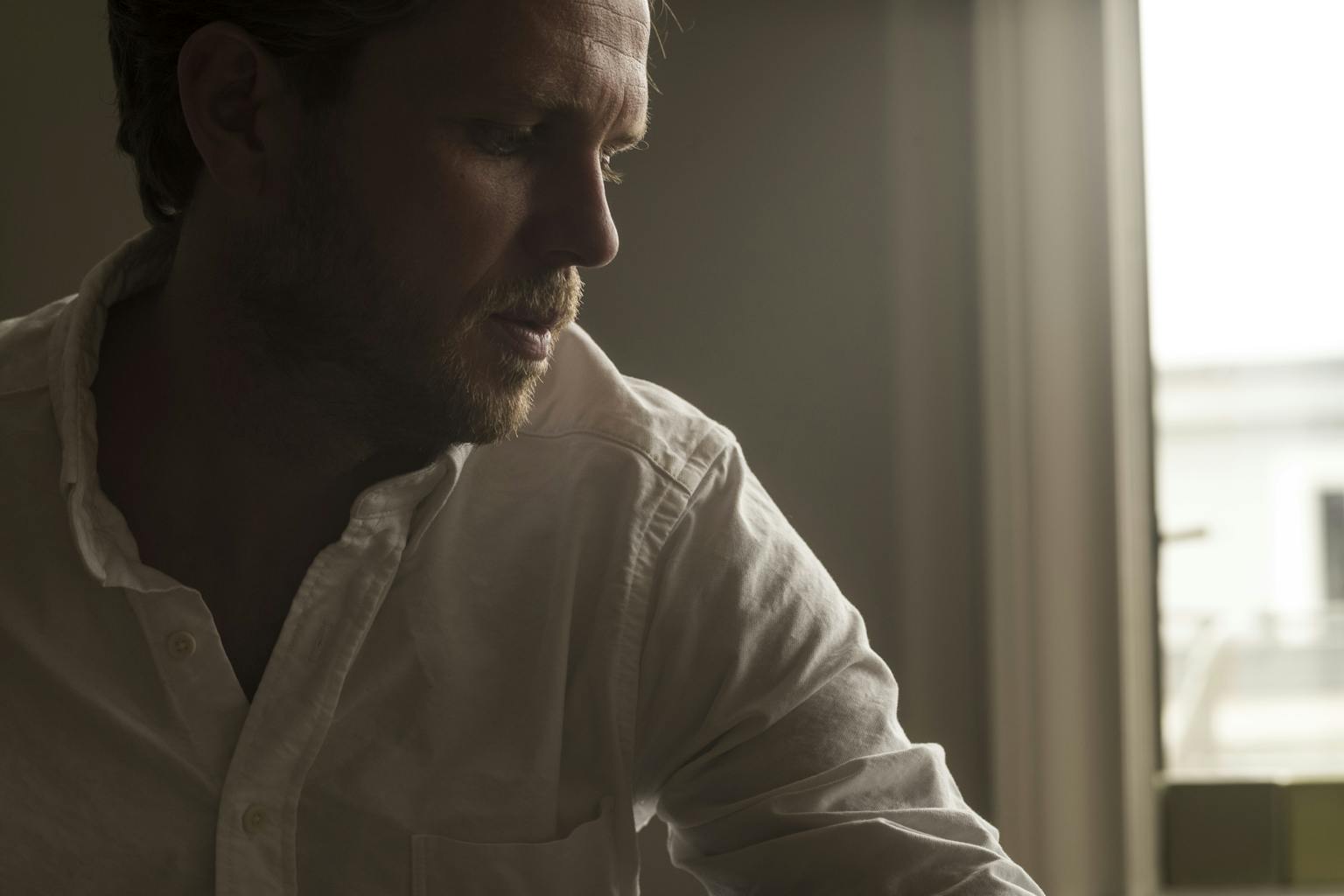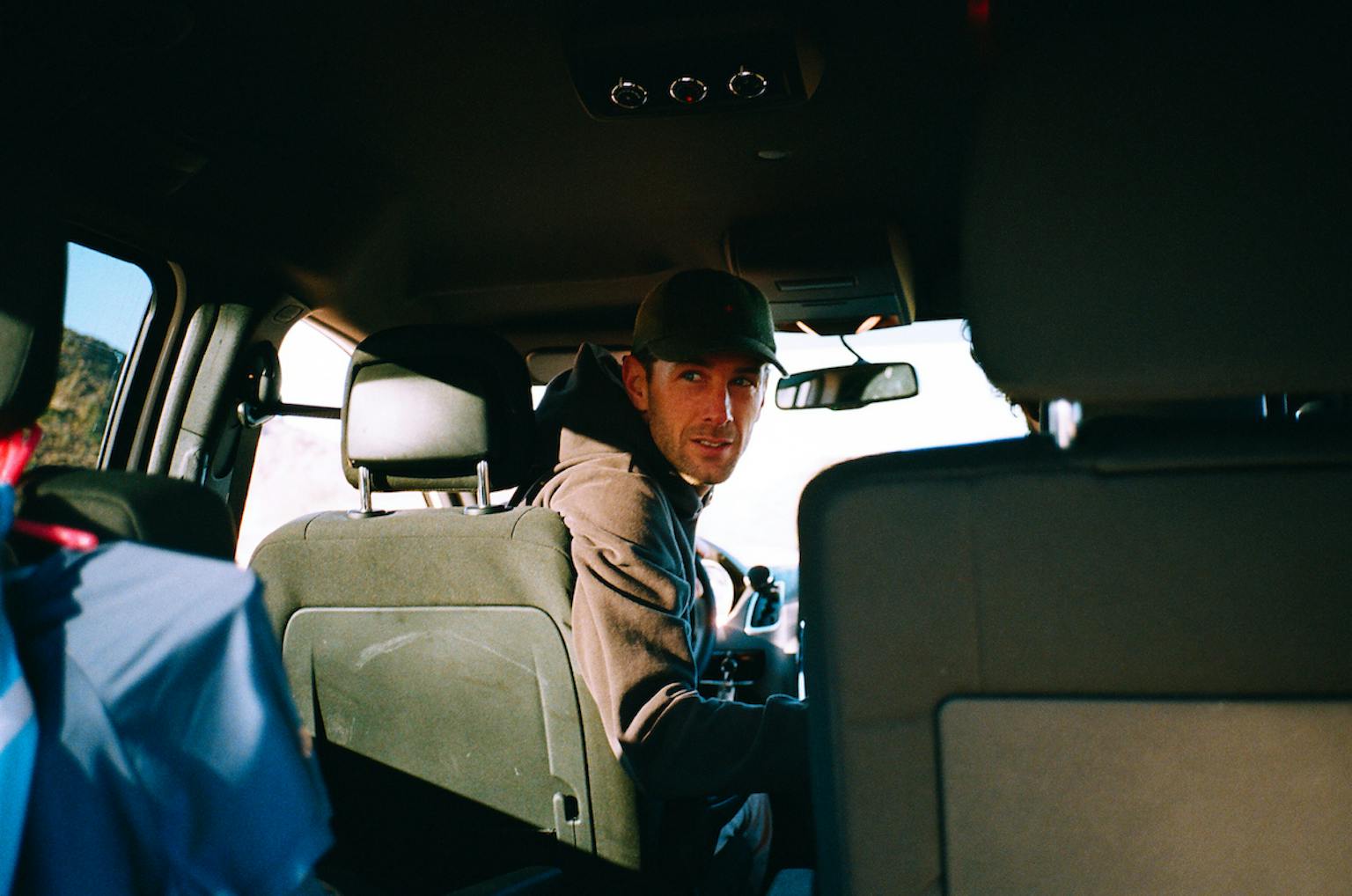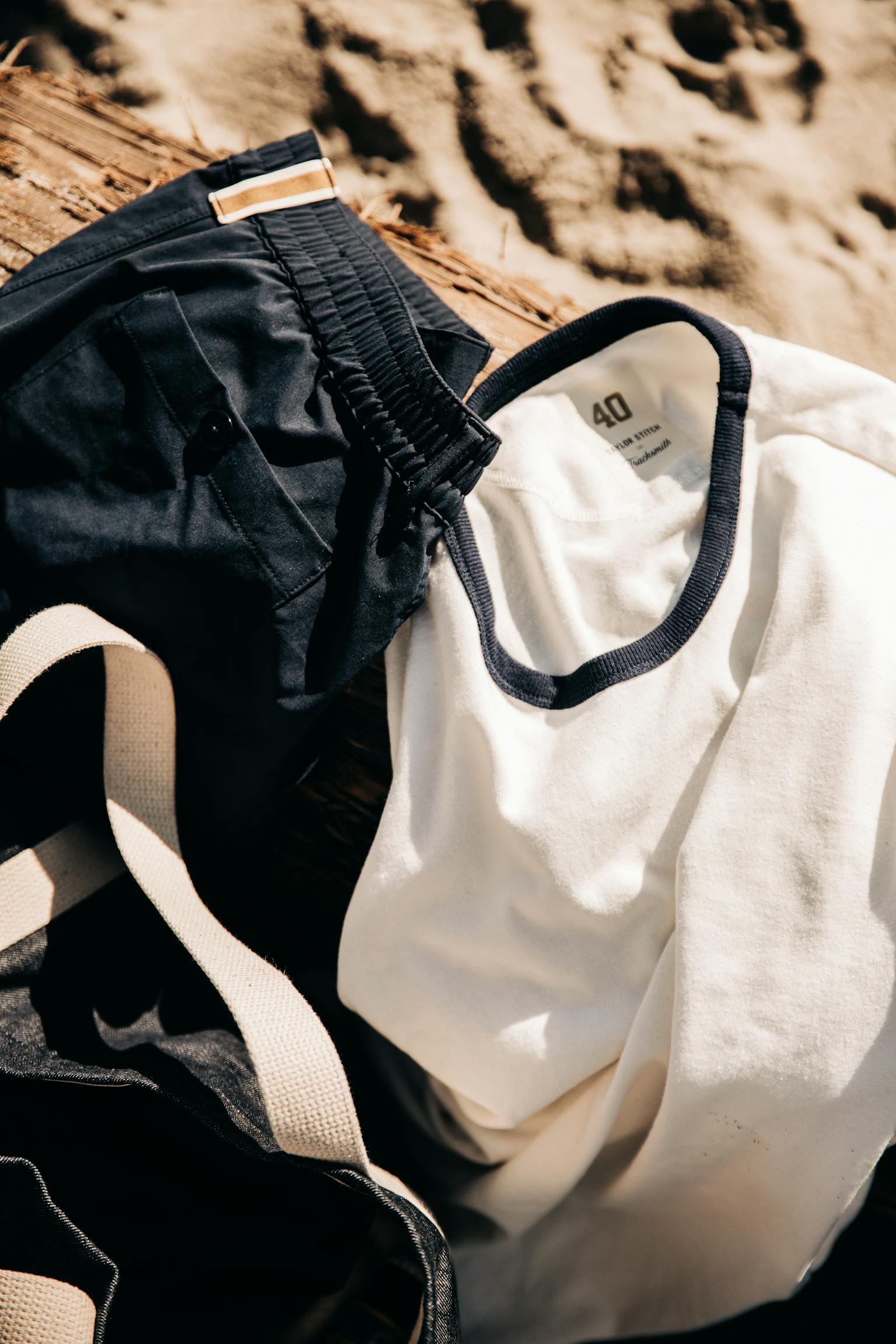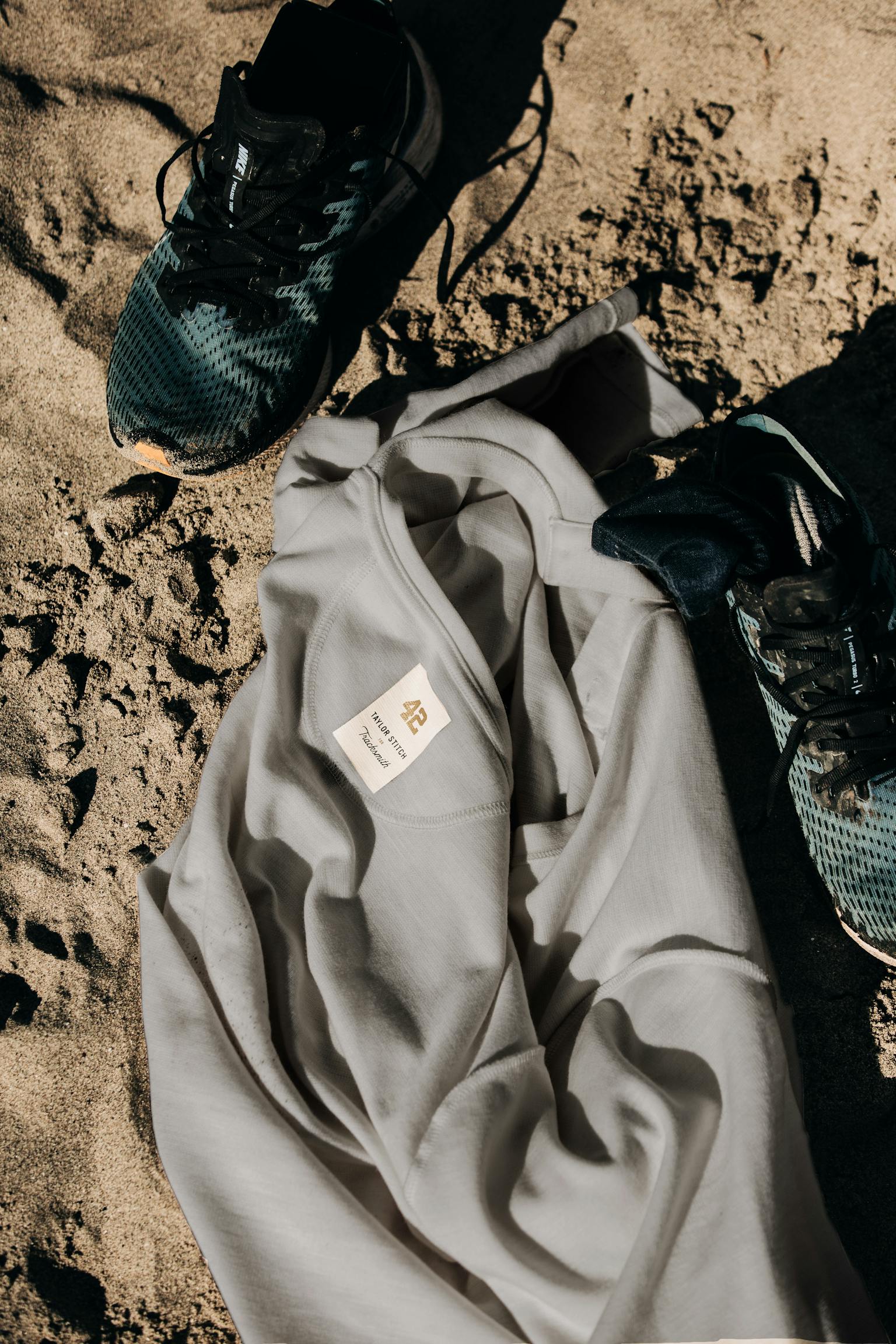
In Conversation:
Tracksmith & Taylor Stitch
Matt Taylor Speaks with Michael Maher
The collaboration between Tracksmith and Taylor Stitch is rooted in a shared point-of-view around craftsmanship, material selection and producing gear that can stand the test of time. Before the launch, Tracksmith founder Matt Taylor and Taylor Stitch co-founder Michael Maher hopped on a Google Hangout for a conversation about entrepreneurship, New England and the lessons they’ve learned on the way to building their brands.
Matt Taylor: So you’re from Maine, originally?
Michael Maher: Yeah, I grew up outside of Portland. Then I went to college at Babson, which is close to Boston, and afterward moved out to San Francisco. I’ve been here since 2007.
MT: Nice. I live like a mile from Babson.
MM:There you go.
MT: And the idea for Taylor Stitch began in college, right?
MM:So my original co-founder and I started the business right after school. The impetus was a custom shirt company. His father would bring back custom shirts from business trips to Hong Kong. Barret would steal them and bring them to college. A lot of the idea was just because we couldn’t find a shirt that fit. We describe ourselves as perfect mediums (5’9”, 175 lbs) and this was the time when Brooks Brothers Slim Fit was still a tent. You’d walk into Neiman Marcus and you could buy a Tom Ford shirt for $495 and it still didn’t fit you under the arms and there was nothing right about the proportions for an everyday slim guy. I thought as health and wellness became more of a care, there’d be more guys concerned about the way they looked. Still, this was 2007, a time when a guy who cared about the way they looked was called “metrosexual,” but we just wanted to wear something that fit. That was really it.
We figured out how to make custom shirts in 2008 and from there it’s transformed into much more of a lifestyle brand. We dialed in our supply chain. We figured out how to make things better. It’s become this brand that takes all our East Coast roots and brings those to California, where we can let our hair down a little bit. Ultimately, that’s the lifestyle that’s come out of it. We didn’t start the business saying “Hey it needs to look this way.” It was more a representation of who we were as people and what we wanted, which was to build great products that were going to last.
MT: Did you start in 2007, is that when you officially launched?
MM:The official launch is a difficult thing to pinpoint. The first time we sold a custom shirt was something like 2008 at our friend’s bar on a Saturday. It finally felt like a business in 2011, when we actually had a store and people came in on a regular basis and bought things and it was the only thing anyone was doing. And we didn’t feel like quitting anymore.
MT: It almost seems like although both of the brands are product brands, we’re both more about the lifestyle. What you said about bringing that lifestyle from the Northeast to the Pacfic Northwest, for us it was very similar. Yes, we want to make a better product, we want to take that margin that you’d usually give up to a wholesale partner and reinvest into better raw materials, but it was much more about the lifestyle. We wanted to build a brand that represented the lifestyle of a committed runner who was training and racing. A runner who was serious about that pursuit even though they weren’t professional.
MM: How did you guys get started? You ran competitively growing up and felt like there was something you wanted that wasn’t in the marketplace?
MT: I ran all through high school and college and competed a little bit afterward. I still do today, I’m just not as fast anymore.
MM: None of us are!
MT: Exactly. I worked in the industry for a long time, much more on the storytelling side and then brand management and marketing. Right before Tracksmith I worked at Puma for about four years. I was the global head of marketing for the running and training categories. So what was lacking, like I said, it wasn't a specific product necessarily, it was more a brand that I felt didn’t exist. One that really resonated with someone like me who was still running and training and cared deeply about the sport. We went through a period in the early 2000s, where the other running brands that you know of, they grew to a point where they had to abandon the core runner. In order to continue growing it became much more of a general health and wellness approach to running.
As I started to put the pieces together, I did have thoughts on product because I didn’t wear most of the running apparel that existed in the marketplace. I was running in things I grabbed from other non-running brands. Whether that was something like board shorts or some nice mid-layer from J. Crew that was just super warm in the winter, just because the aesthetic of the running apparel didn’t appeal to me at all. At the time it was all very neon and quite futuristic. Nothing matched my wardrobe for everyday life. And then when I started digging into the apparel side of things more, it became really clear that there were these fabrics that were really amazing, like Merino wool or four-way stretch wovens from Schoeller that didn’t fit into the typical pricing structure for running apparel. They’re amazing, but they’re more expensive. So for Nike or Brooks to use that fabric and then try to sell it at Dick’s Sporting Goods, it would put the price at a point that was way beyond what makes sense in that environment for that garment.
MM: The Schoeller fabrics are not inexpensive. Beautiful though!
MT: It’s funny, we’ve had a few fabrics that have been in the range since the beginning, and we’ve tried to duplicate those somewhere else. And you just can’t. You can’t get the same performance, hand feel and innovation. You can get one or two of the variables, you’ll never get all three. So we still use Schoeller quite a bit.
MM: I have this old pair of Cloud Vail gloves and they’re 25 years old and I still wear them skiing every year. All Schoeller tech and Schoeller leather as well, and they’re still mind-blowing.
MT: I think the Cloud Vail founder was from Maine, too.
MM: It’s strange how many Maine guys have ended up in apparel. It’s gotten to the point that it’s weird. Are you originally from the Northeast as well?
MT: I grew up in Pittsburgh, where we have East Coast desires with Midwest sensibilities. That’s it in a nutshell. But I went to college at Yale in 1995 then moved to Boston and have been pretty much a New Englander ever since. It’s funny, I don’t know if you’ve ever had these sorts of questions but I often get asked. “Isn’t New England sort of limiting?” But I think having a sense of place can be a really important part of a brand’s identity. It doesn’t have to be, but when used appropriately it can be a differentiator. If you’re a surf brand you want to be in Southern California or Hawaii, if you’re a ski brand you want to be in the Mountains. New England has this amazing history with running, not only with the Boston Marathon but all of the universities D1 to D3, high schools and clubs, there’s this amazing legacy. You also get the four seasons here which means running cross country and indoor and outdoor - you get to experience all those changing conditions. We definitely lean into New England for those reasons.
I also think that the values of being practical, straightforward, using what’s needed and not more, has influenced our design. We don’t add stuff just to add. The industry had definitely gone in that direction, especially in footwear. The conversations were literally, “Well, if we add another overlay the perceived value on the shoe wall is going to be higher.” It adds no functional value to the shoe, it’s just trying to deceive the customer that there’s more going on, so you’ll pay a higher price. That timeless, less-is-more aesthetic that exists in New England has influenced our approach for sure.

MM: I feel the same way. It’s funny our best customer is often an East Coast person that moved to California. They get every sense of it. For me, I grew up 15 minutes from L.L.Bean. L.L.Bean was this northstar of product durability and customer service. We had bean boots at our house from the 70s that when the rubber would finally run out my dad would just throw epoxy over it. You could still fix everything. That’s how we’ve built Taylor Stitch. So every time we make a boot we want to make sure it’s re-soleable. We love the way that denim fades and that you re-wax canvas and things of that nature. It feels inline with that aesthetic that you guys do as well, there’s this care and sensibility of place.
The superfluousness of those things you were talking about, they’re just unnecessary. We would rather put fewer things on it that are better and going to last. We always had this running joke of “If we do our job well enough, we should put ourselves out of business, because people shouldn’t need to buy more clothes.” That’s always how I feel. I wear the same few things we make time and time again. When you build things that are meant to last, they do. You don’t need more waste. The amount of waste that the clothing industry creates is absolutely awful. Everyone we look to and partner with has the same kind of idealism. Which in many ways is an idealism, due to the way that the rest of the industry operates.
MT: In running, the industry got to that point because the big box sporting goods stores wanted something new every three months to keep the customer coming back. That forced design teams to be constantly throwing things at the wall, predominantly colors. I’d be able to tell you “Oh that was 2005, that was 2008.” It was so obvious. It was applying fast fashion to a performance category. By being direct, as you know, you’re not at the whim of a merchandiser at a big retail chain and you can sort of do what you want. If we’re being honest, too, as a smaller, growing brand, a lot of the efficiencies of being able to utilize a certain color or fabric over two or three years is really helpful when maybe you’re not able to hit all the minimums But, as you know, making physical products can be really hard. I’m curious how you’ve approached the process?
MM: We have this base of silhouettes. From there, we really like developing fabrics and we lean hard into making sure that the fabrics that we do are interesting. Our design ethos is always let's make something differentiated. We’re doing a design review for Q3 right now and we do take some really aggressive stances on making fabrics and sometimes it doesn’t work. We’ll go back and re-work it. It takes a lot of time. We’ve been working on making a denim for two years with our manufacturers. It’s tough to get right. I give our product team all the credit in the world for not giving up. There’s just this virtue in caring and going back to the well and saying “We didn’t get it right and we’re not releasing until we do.” Recently, we really pushed hard on getting more organic cotton in the line. We went from 0% organic cotton in 2017 to 99% in 2020. We’re pushing on recycled fabrics and renewable fabrics, which is an essential we look to while sourcing.
MT: Trying to develop those fabrics is interesting. Merino for us is probably a really good analogy. Merino is an amazing fiber, but for doing something active for a really long period of time it can be challenging. We’ve gone through that same process where we’ve tested so many combinations with Merino. Sometimes they work amazingly well and end up in the line, and sometimes they don’t. We’ve worked really hard to find blends that work for specific use cases.
We’re in a similar place with outerwear right now. Our NDO Jacket is amazing, that’s probably our best piece of outerwear. But it’s really hard to perfect outerwear. The industry is predominantly built to keep you warm and dry when you’re standing still, or moving but not generating heat. So trying to solve staying dry but not overheating is tough. Any fully waterproof jacket, you could never run in for 10 miles. So those are the challenges we’re still working through. That comes back to New England, we do have to face those conditions. The other day, we had a torrential downpour and I had this proto of a new rain jacket. I was so excited to test it. I went 6 miles and 3 miles in the rain seeped through. We built some vents and they weren’t working. I’m thinking, “Damn! This isn’t it! Back to the drawing board.”
MM: Truly developing good products is challenging. There’s a lot of people developing crappy products out there that look good for a short period of time but don't hold up. It’s a lot about care and attention to detail on the make too. How’s it being sewn? Our main designer owned a custom denim company. He’s a sewer first and a designer second. He’s always cared so much about the way something is sewed, the way it looks inside. He’d prefer to flip a pair of jeans inside out and look at them. That’s the first he does, looks to see if they sewed it right. Start from the inside out, make sure it’s going to last.
MT: I didn’t do this on purpose but I realize I’m wearing your Henley in our Downeaster fabric. I forgot this was one of the first protos of our collab that came in. I wear it all the time. It's amazing.
MM: Love it!
MT: But your background wasn’t in design necessarily?
MM: Far from it, I didn’t really have a background. I graduated college, moved out here, did a little high-end home remodeling while we were trying to get Taylor Stitch off the ground. I always knew I wanted to start a business. The college I went to, the only thing you can get is a BS in Business Administration. I was very lucky, I had this teacher in high school who built this whole business program at this small high school outside Portland, Maine. By the time I graduated high school I had taken 6 business classes, things like accounting, strategy, and marketing. We were doing the UPS HBS case study in high school. So I had this innate love for starting businesses. For me the clothing thing came from, “Hey this could be interesting. I like brands. It’s fun to build brands and community.”
I always look back to what L.L.Bean had done. My north star with that one was, I was going on a fishing trip with my buddy to Labrador, Canada. We were leaving on a Saturday at 6 a.m., it was Friday going into Saturday at 1 a.m. and my buddy didn’t have the gear we needed. So we hopped into the truck and went to the L.L.Bean and they had a person talking to you about the region we were fly fishing in and the things he needed. We were dumbstruck by the level of service. I always felt like, if we could build a community and service those customers in a way that makes them feel special and gives them a good product, they’re going to keep coming back.
MM: It’s easy to talk through all the great things that happen on the way to building a brand. I always loved when entrepreneurs visited in college to hear about the tough days. What were the darkest days for Tracksmith? I like asking because it shows the mental fortitude of founders. There were so many times building Taylor Stitch when I was like “We should just quit. We should go get jobs.”
MT: I’d say I had one really dark period, a few years ago where we got ourselves in a tight cash crunch situation. Needs to buy inventory outweighed our pace of generating revenue. We were weeks away from running out of money. We made it through, but not without a lot of sleepless nights. I thought about walking away or trying to sell. None of those things happened and we made it through it, but it’s a scary part of starting a business, especially when it starts to grow fast.
The other one is – and I’d be curious about your thoughts on this – I really did not anticipate the people needs of being a founder. It was easy with 1, 2, 3 people. But you quickly realize that people are depending on you - to pay them, to develop them, to lead them - in a way that’s much different than when you’re just managing someone.
MM: Yeah, I can speak to both things. There were dark days where we had no funding and had to basically take a debt deal, that was very expensive. We finally climbed out of that, the guys were great, they came in and funded the business when no one else would. That’s scary! The credit card was more than the cash was coming in. These businesses are so inventory heavy, it’s not that the business is unhealthy. It’s just that you miss-bought inventory one time and you screwed yourself.
In 2010, we had a 4,500-sq-foot space, arguably the worst area in the city to do anything but throw underground house parties. We were selling coffee in the morning to anyone going by, selling clothes during the day, running a co-working space and an art gallery/function space. We had this amazing Halloween Party and that was the breaking point, we all went home for Christmas and were so tired. Beat up, broken down.
Around that time my co-founder found a space on Valencia Street that ended up being our store. If he hadn’t signed a 1-year lease and said “Let’s refocus, give this one more year and see what happens. Let’s focus just on clothing and see what happens,” we probably would have bailed. And it worked. We opened next to Four Barrel Coffee and hundreds of people were getting cappuccinos every day and swinging into our store and saying hello. That transition was really interesting. It was the turning point where we realized maybe this is a business and we can do this. We can pay ourselves a few thousand dollars a month.
On the people side. I still feel like that’s the hardest. We hired a General Manager who was much better than me at it. For a while it was just the three of us, the transition point came when we had real employees we were responsible for and we couldn’t just yell and swear at each other and have knockdown fights with our co-founders. They were my best friends, we could do that stuff!
MT: How many employees do you have now?
MM: 15-20 and three or four folks in Maine. What about you?
MT: We have 27. Everything’s pretty much in-house.
MM: It's a challenge the people thing. There’s this transition point where you need someone to make an executive decision. You need that change agent that’s like let’s just move. Whether you’re right or wrong, you go with it.
MT: I’m a slow decision-maker. I’m an observationalist. I like to gather as much information as possible, which drives the team nuts.
MM: That letting go is the biggest thing I have tried to do. The best thing I can do for someone I manage is say, 'I’m here if you need me. But don’t feel like you always need me.” Otherwise, you can never scale-out beyond yourself.
MT: How do you let go outside of work? What’s a weekend adventure?
MM: Weekend adventure these days is mostly trying to wrangle a 2-year-old and keep them happy. But you know, I count myself lucky because of where I live. My weekend adventure is this famous run out here called the Ninja Loop.
I never counted myself much of a runner, I played lacrosse in college but I was never the guy excited to do the 2miles under 12-minute training after Christmas break, where it was 32 laps of the indoor track. As I’ve gotten older I learned to appreciate running and I ran a lot last year, I set the goal of running this 11.5 mile 2,300 feet of climbing loop through the headlands. That’s my weekend adventure. Get out on that, finish in the parking lot with some buddies. It reminds me of why I love being here so much. We’re lucky to be doing this in January and it’s 65 degrees.

MT: The connection that’s cool for us is that the first photoshoot we did outside of New England was outside of San Francisco in Bolinas. And we shot for a weekend there. We ran all around there and at Stinson Beach. We’ve been back a few times since then and shot in Mill Valley and around Mt. Tam. Even though we’re a New England-based brand, the place we’ve shot the most outside of New England is in the Bay Area. It’s different, the majestic nature of all of it and being so close to a huge city is unique.
MM: We did a double Dipsea run with some of the Taylor Stitch guys the day after Thanksgiving. If you asked me two years ago if I’d do that, I’d say you’re insane. One of the better things that have come out of the pandemic has just been that flexibility to go run and ride bikes and have some quick adventures.
MT: Quick adventures are all you get as a dad/founder these days. But it’s worth it.
To see more from the Taylor Stitch Collection and support the Workshop visit TaylorStitch.com.




